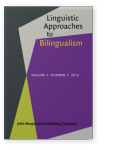Commentary
We need an integrated, multiple-predictor model of native language proficiency
Irina Sekerina | College of Staten Island, The City University of New York
Article outline
- Theory: The ‘third variable’ problem
- Methodology: Accuracy measures and statistical modeling
-
References
References (12)
References
Bayliss, D.M., Jarrold, C., Gunn, D.M., & Baddeley, A.D. (2003). The complexities of complex span: Explaining individual differences in working memory in children and adults. Journal of Experimental Psychology: General, 1321, 71–92. 

Connor, L.T., MacKay, A.J., & White, D.A. (2000). Working memory: A foundation for executive abilities and higher-order cognitive skills. Seminars in Speech and Language, 211, 109–119. 

Conway, A.R.A., Kane, M.J., Buntig, M.F., Hambrick, D.Z., Wilhelm, O., & Engle, R.W. (2005). Working memory span tasks: A methodological review and user’s guide. Psychonomic Bulletin and Review, 121, 769–786. 

Fernald, A., Zangl, R., Portillo, A.L., & Marchman, V.A. (2008). Looking while listening: Using eye movements to monitor spoken language comprehension by infants and young children. In Sekerina, I.A., Fernández, E.M., & Clahsen, H. (Eds.), Developmental Psycholinguistics: On-Line Methods in Children’s Language Processing. (pp. 97–136). Amsterdam: John Benjamins. 

Jaeger, T.F. (2008). Categorical data analysis: Away from ANOVAs (transformation or not) and toward logit mixed models. Journal of Memory and Language, 591, 434–446. 

Mortimer, J.A., Snowdon, D.A., & Markesbery, W.R. (2003). Head circumference, education, and risk of dementia: Findings from the Nun Study. Journal of Clinical and Experimental Neuropsychology, 251, 671–679. 

Obler, L.K., & Pekkala, S. (2008). Language and communication in aging. In B. Stemmer & H. Whitaker (Eds.), Handbook of Neurolinguistics (2nd Ed., pp. 351–358). Oxford: Elsevier Press.
O’Grady, W., Suguzi, T., & Yoshinaga, N. (2010). Quantifier spreading: Evidence from Japanese. Language Learning and Development, 6(2), 116–125. 

Ramirez, J.D., Wiley, T.G., Klerk, G.D., Lee, E., & Wright, W.E. (Eds.) (2005). Ebonics. The Urban Education Debate. 2nd Ed. NY: Multilingual Matters Ltd.
Sekerina, I.A., & Sauermann, A. (in prep). Quantifier spreading in eye movements: A case of the Russian quantifier kazhdyj ‘every’.
Stern, Y. (2009). Cognitive reserve. Neuropsychologia, 471, 2015–2028. 

Swets, B., Desmet, T., Hambrick, D.Z., & Ferreira, F. (2007). The role of working memory in syntactic ambiguity resolution: A psychometric approach. Journal of Experimental Psychology: General, 1361, 64–81. 

Cited by (2)
Cited by two other publications
Sekerina, Irina A & Antje Sauermann
2015.
Visual attention and quantifier-spreading in heritage Russian bilinguals.
Second Language Research 31:1
► pp. 75 ff.

This list is based on CrossRef data as of 5 july 2024. Please note that it may not be complete. Sources presented here have been supplied by the respective publishers.
Any errors therein should be reported to them.
